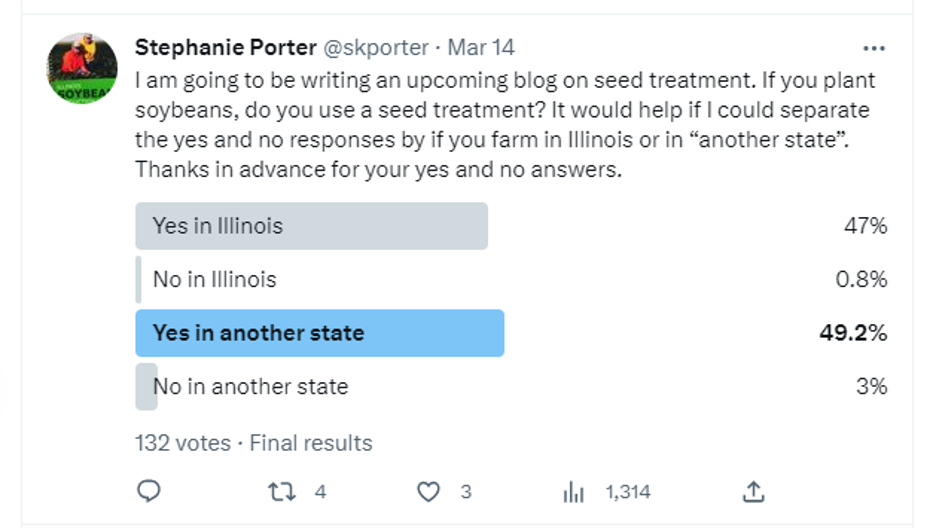Recently, I polled Twitter followers to see how many used seed treatment on soybeans. You can check out the results here:

Product Research and Data
Billions of dollars are invested by multiple companies to bring the best seed treatment products to market. Companies have their own data sets for their seed treatment packages from various locations over many years. Since there are usually small statistical differences when comparing various seed treatment packages, some focus on the visual evaluation of how well these products perform at emergence, especially under unfavorable conditions. Pay attention to data from third party or non-biased resources such as universities. As with any product, you should ask a lot of questions about the data and check if their test results are coming from a greenhouse or the field. It can be very difficult to test seed treatment components out in the field because pests and diseases may not be present or uniform across the field.
Disease
Seedling diseases such as Pythium spp., Phytophthora sojae, Rhizoctonia solani, Fusarium spp. or more specifically, Fusarium virguliforme (SDS) may be lurking in fields, especially in compacted, wet, or poorly draining areas. Cool weather that slows emergence or perhaps soybean cyst nematode injury allows for a more favorable environment for diseases to infect soybeans. With disease, soybeans may fail to emerge or die after coming out of the ground. In other instances, soybeans infected with a seedling disease may appear stunted with visible symptoms that may give us a clue that something is wrong. Genetic resistance is available for managing Phytophthora; however, the many “fungicide” components in a seed treatment can help to reduce seed and seedling diseases. There is a reason that seed treatments consist of several fungicide components and this is because not all active ingredients are effective against all pathogens. For example, active ingredients, mefenoxam and metalaxyl, have activity on oomycetes, while strobilurins (azoxystrobin, trifloxystrobin, pyraclostrobin) combat diseases such as Fusarium and Rhizoctonia. Fortunately, the Crop Protection Network releases a “Fungicide Efficacy for Control of Soybean Seedling Diseases” publication every year to help us keep track of which fungicide active ingredients work the best against each of these diseases.
SCN
Soybean cyst nematode (SCN) cysts can remain in the soil for several years and each cyst can contain more than 100 eggs. When they hatch, the juveniles will migrate to the plant root, set up feeding sites and steal nutrients, which can result in yield loss. SCN has also been deemed the “gateway for disease.” There are newer seed treatments that offer early season SCN control, but this is not considered a “stand alone” treatment. The integrated management of SCN has not changed, but we also have come to realize that the use of a single source of resistance is not a viable long-term strategy for managing SCN. Crop rotation to non-hosts such as corn can help, but this does not eliminate SCN populations. It just decreases them.
Insects/Bean Leaf Beetle
The insecticide component in a soybean seed treatment obviously helps to protect seeds and seedlings from insects. One of the most common pests of earlier planted soybeans is bean leaf beetle. Again, it can be difficult to research and prove the effectiveness of the insecticide component of a seed treatment, but if you get 30 percent defoliation before bloom (Illinois) or start to get 2 to 4 beetles per plant at VC to V1 soybean growth stages (Nebraska), treatment may be warranted. We also need to realize that the bean leaf beetle is a vector for bean pod mottle virus that can be responsible for stay-green or a delay in soybean maturity as well as yield loss. No foliar treatment is necessary if you have already invested in a seed treatment that consists of an insecticide. Some companies claim an additional growth or vigor effect from a neonicotinoid insecticide seed treatment component, and I have visually seen this in side-by-side comparisons. Many question the need for an insecticidal component within seed treatments and they may not be warranted with some environments, later planting dates, or lower insect pressures.
Reducing Soybean Planting Populations
By investing in high-quality seed with treatments, research has shown planting populations can be reduced. Seed treatment protects your seed investment when planting early. Reducing the seedling rate can be a very important management decision when factoring in seed cost. A full seed treatment can result in greater emergence and vigor as well as a more uniform stand. Ultimately, an optimal plant population for soybean production can increase both yield and profitability. As we continue to plant earlier each year to achieve higher yields, “seeing is believing” when evaluating seed treatments.


 and then
and then